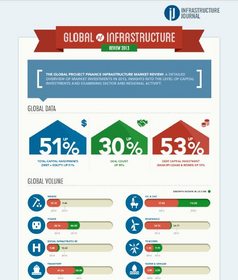LONDON, UNITED KINGDOM--(Marketwired - Feb 4, 2014) - Infrastructure Journal has published its annual 2013 Global Infrastructure Market Review. Our league tables show that the biggest lenders to infrastructure are no longer the European banks. Banks from the Asia-Pacific region, including Australian institutions, have continued to take market share from the historic leaders. Of Europe's banks only ING Group, Credit Agricole Group and BNP Paribas remain in the top 10, with most of their lending focused on Europe and the Americas.
In 2013 the global infrastructure finance market recovered in all geographic regions. Although global project finance (PF) markets are far from mended, 2013 offered signs of improvement, after a poor 2012.
IJ data show that total investment in global infrastructure reached US$280 billion, which was a 51 per cent increase from the preceding year. A total of 548 deals reached financial close, an increase of 30 per cent.
Notably, the power sector has attracted higher levels of investment than renewable energy, on the back of strong activity in conventional power development in Asia & Pacific and Africa and the Middle East.
The Americas was the largest geographic market for infrastructure investment with deals valued at US$78 billion, split between energy, mining and social and transport infrastructure. Asia-Pacific was second, with $76 million, with Australian energy and infrastructure financings leading the way. Europe was a close third, with financial close on transactions in transport, social and renewable energy infrastructure.
Australia and the US are the largest single jurisdictions for project finance. The shale gas boom has been responsible for a surge in energy financings in the US, including a number of midstream projects in the US in 2013.
The largest global project finance transaction in 2013 was the US$34 billion Ichthys LNG in Australia. It raised an impressive US$20 billion debt package from 20 banks, with the support from eight export credit agencies.
As a result of these and other landmark financings, oil & gas led the way by overall financing volume in 2013, with developers netting US$113 billion. Transport was second, with just over US$50 billion, and in a reversal of 2012, conventional power beat renewables into third place, with the sectors receiving over US$40 billion and US$35 billion, respectively.
Despite the regulatory constraints facing many project finance banks the availability of long-term debt was not an obstacle to closing financings in 2013. There was an increase in the participation of non-bank lenders in financings for infrastructure. These sources have yet to realize their full potential and are likely to become a crucial source of infrastructure finance.
For more information, or to download the IJ Global Project Finance Infrastructure Review 2013, please visit this link. For details please contact Annika Kiestra at +44 (0) 20 7827 6427 or email akiestra@euromoneyplc.com.
About Infrastructure Journal
Infrastructure Journal is an online information resource that tracks global market activity to deliver real-time news, insight and data to underpin your investment decisions. IJ has a core focus on traditional infrastructure, equity fund market and institutional investors, but is also applying a greater focus on alternative sources of infrastructure debt financing and providers of infrastructure finance. We are committed to providing more data insights to allow you to analyse trends and changes in the market. For more information, please visit www.ijonline.com
